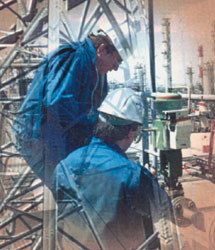France: New approach improves E & I project performance
Apr. 2002 Vol. 223 No. 4 European Technology Round Up
Philippe Lecois, Vice President, and Geoffrey Lyon, Business Development Director, Cegelec-Comsip Division The "Vertical Integration Approach" (VIA) is a method that allows EPC (evaluation and procurement) and EPCC (evaluation, procurement and construction) contractors to be more competitive, spread risks, improve the quality performance on EPCC grass roots projects and assure that the schedule end-date is met. The key to success of all EPC or EPCC contracts is to achieve the best possible coordination of the horizontal and vertical planes. First, there is the horizontal spread between all the different disciplines, such as process, piping, structures, rotating equipment, E&I, etc. Second – even more critical – is the vertical spread between the different project phases – conceptual design, detailed design, procurement, construction and commissioning. While EPC contractors generally achieve very good interfacing and coordination between different disciplines, there are often difficulties in getting good vertical interfacing between the detailed design, procurement, construction and pre-commissioning / commissioning. This is particularly true for the E&I (evaluation and installation) disciplines, especially instrumentation and controls, where:
The object of VIA is to improve or eliminate vertical interface problems while not jeopardizing the critical need to maintain perfect interfacing between different disciplines, particularly in the engineering phase. Cegelec, a leader in E&I disciplines, achieves this by integrating itself into the EPC contractor structure as early as possible in a project. That way, the same integrated organization and the same people are involved from design through procurement, construction and commissioning. This is achieved by physically integrating a company team into the EPC contractors’ design office. Team members interface perfectly with the contractors’ own E&I conceptual design engineers, who carry out their traditional roles by interfacing with the Process Department, the Rotating Equipment Department, etc. The role of a firm like Cegelec at this stage is to begin taking over responsibility for engineering discipline. Above all, the company must assure perfect coordination on layouts with the Piping and Structural Departments, and assure constructability by engineers who are thoroughly versed in the practicality of field installations in an international environment. Beyond this phase, much of the specification and procurement of equipment and materials, and detailed design, does not require the design team to be physically present in the EPC contractors’ office. As coordinator, a firm like Cegelec offers IT support to accomplish perfect coordination with the EPC(C) contractor. |
|||||||||||||




